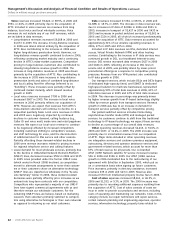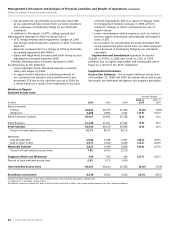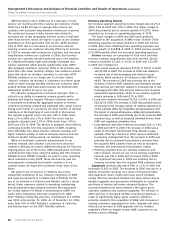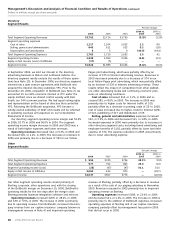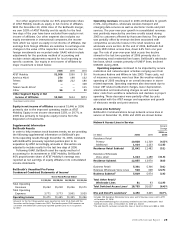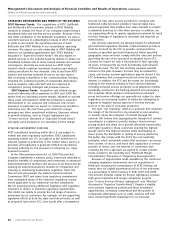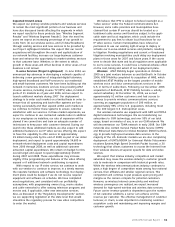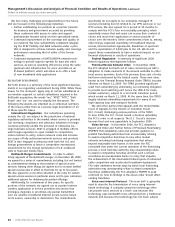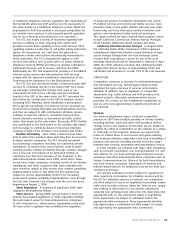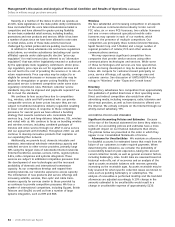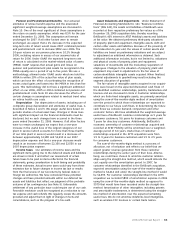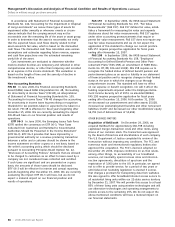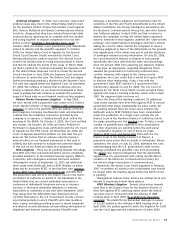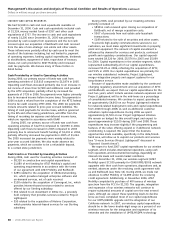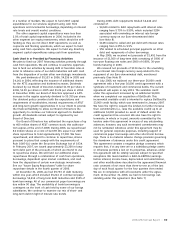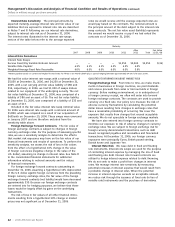AT&T Wireless 2006 Annual Report Download - page 34
Download and view the complete annual report
Please find page 34 of the 2006 AT&T Wireless annual report below. You can navigate through the pages in the report by either clicking on the pages listed below, or by using the keyword search tool below to find specific information within the annual report.
32 : :
2006 AT&T Annual Report
Management’s Discussion and Analysis of Financial Condition and Results of Operations (continued)
Dollars in millions except per share amounts
We face many challenges and opportunities in the future
and are focused on the following key initiatives:
• Further establishing our position as a premier provider
for business and government accounts by providing
these customers with access to sales and support
professionals focused solely on their specialized needs.
• Continued improvement on the coverage and quality of
our network. We have substantially completed integrat-
ing the AT&T Mobility and AWE networks under a plan
that is designed to achieve network quality and coverage
performance exceeding that of either of the former
networks.
• Continued deployment of UMTS/HSDPA network tech-
nology to provide superior speeds for data and video
services, as well as operating efficiencies using the same
spectrum and infrastructure for voice and data on an
IP-based platform, which will allow us to offer a host
of new broadband data applications.
REGUL ATORY D EVELOP MENTS
Set forth below is a summary of the most significant develop-
ments in our regulatory environment during 2006. While these
issues, for the most part, apply only to certain subsidiaries in
our wireline segment or certain subsidiaries acquired in the
BellSouth acquisition, the words “we,” “AT&T,” “ATTC,” “Bell-
South” and “our” are used to simplify the discussion. The
following discussions are intended as a condensed summary
of the issues rather than as a precise legal description of all
of those specific issues.
International Regulation Our subsidiaries operating
outside the U.S. are subject to the jurisdiction of national
regulatory authorities in the market where service is provided.
Our licensing, compliance and advocacy initiatives in foreign
countries primarily enable the provision of enterprise (i.e.,
large business) services. AT&T is engaged in multiple efforts
with foreign regulators to open markets to competition,
reduce barriers to entry, reduce network costs and increase
our scope of fully authorized network services and products.
AT&T is also engaged in advocacy with both the U.S. and
foreign governments to foster a competitive international
environment for the foreign termination of U.S.-outbound
calls to fixed and mobile lines.
BellSouth Merger Commitments In order to obtain
timely approval of the BellSouth merger, on December 28, 2006
we agreed to a series of commitments, including, but not limited
to, commitments relating to the provision of special access
services. Among other things, we agreed not to increase tariffed
special access rates in effect at that time for up to four years.
We also agreed to a one-time reduction in the rates for certain
special access services in particular areas, and to give customers
additional options for obtaining discounted offerings.
Additionally, for a maximum of two years, for specific
portions of the network, we agreed not to provide Internet
content, application or service providers any service that
privileges, degrades or prioritizes any packet transmitted
over our wireline broadband Internet access service based
on its source, ownership or destination. The commitments
specifically do not apply to our enterprise managed IP
services (including but not limited to our VPN services) or our
IPTV service. We also agreed, for a period of 30 months, to
comply with the FCC’s four net neutrality principles, which
essentially ensure that end-users can access their content of
choice and reach their application or service provider of
choice over the Internet. Other commitments relate to, among
other things, expanded availability of broadband Internet
access, interconnection agreements, divestiture of spectrum
and the repatriation of 3,000 jobs to the U.S. We do not
expect these commitments to have a material impact on our
financial statements or results of operations.
Federal Regulation A summary of significant 2006
federal regulatory developments follows.
Triennial Review Remand Order In December 2004,
the FCC adopted its fourth set of rules concerning an ILEC’s
obligation to make elements of its network available to other
local service providers. Each of its previous three sets of rules
had been overturned by the federal courts. These new rules,
known as the Triennial Review Remand Order (TRRO), became
effective on March 11, 2005. The TRRO provided significant
relief from unbundling by eliminating our remaining obligation
to provide local switching and, hence the UNE-P, for mass-
market customers, subject to a 12-month transition period,
which ended on March 11, 2006. At the same time, the TRRO
largely retained unbundling requirements for many of our
high-capacity loop and transport facilities.
We and other parties filed appeals with the United States
Court of Appeals for the District of Columbia Circuit
(D.C. Circuit) challenging various portions of the TRRO.
In June 2006, the D.C. Circuit issued a decision upholding
the FCC’s order in all respects. The D.C. Circuit’s decision
became final and non-appealable in September 2006.
Video Service In December 2006, the FCC adopted a
Report and Order and Further Notice of Proposed Rulemaking
(FNPRM) that establishes rules and provides guidance to
prohibit franchising authorities from unreasonably refusing
to award competitive franchises to new video market
entrants, including franchising negotiations that extend
beyond reasonable time frames. In the order the FCC
concluded that under the current operation of the franchising
process, a local franchise authority may unreasonably refuse
to award a competitive franchise and that such a refusal
constitutes an unreasonable barrier to entry that impedes
the achievement of the interrelated federal goals of enhanced
cable competition and accelerated broadband deployment.
The order addresses several ways by which local franchising
authorities may unreasonably refuse to award competitive
franchises. Additionally, the FCC adopted a FNPRM to seek
comment on how its findings in the above order should affect
existing franchises.
Voice over Internet Protocol The term VoIP is generally
used to describe the transmission of voice using Internet-
based technology. A company using this technology often
can provide voice services at a lower cost because this
technology uses bandwidth more efficiently than a traditional
network and because this technology has not been subject


